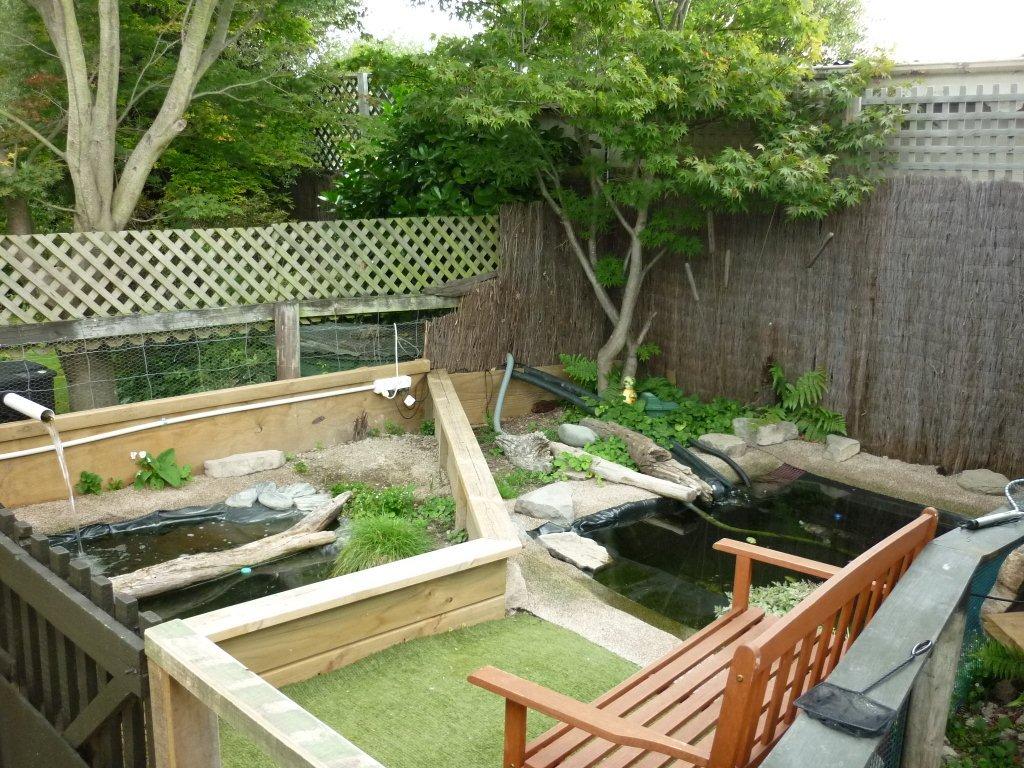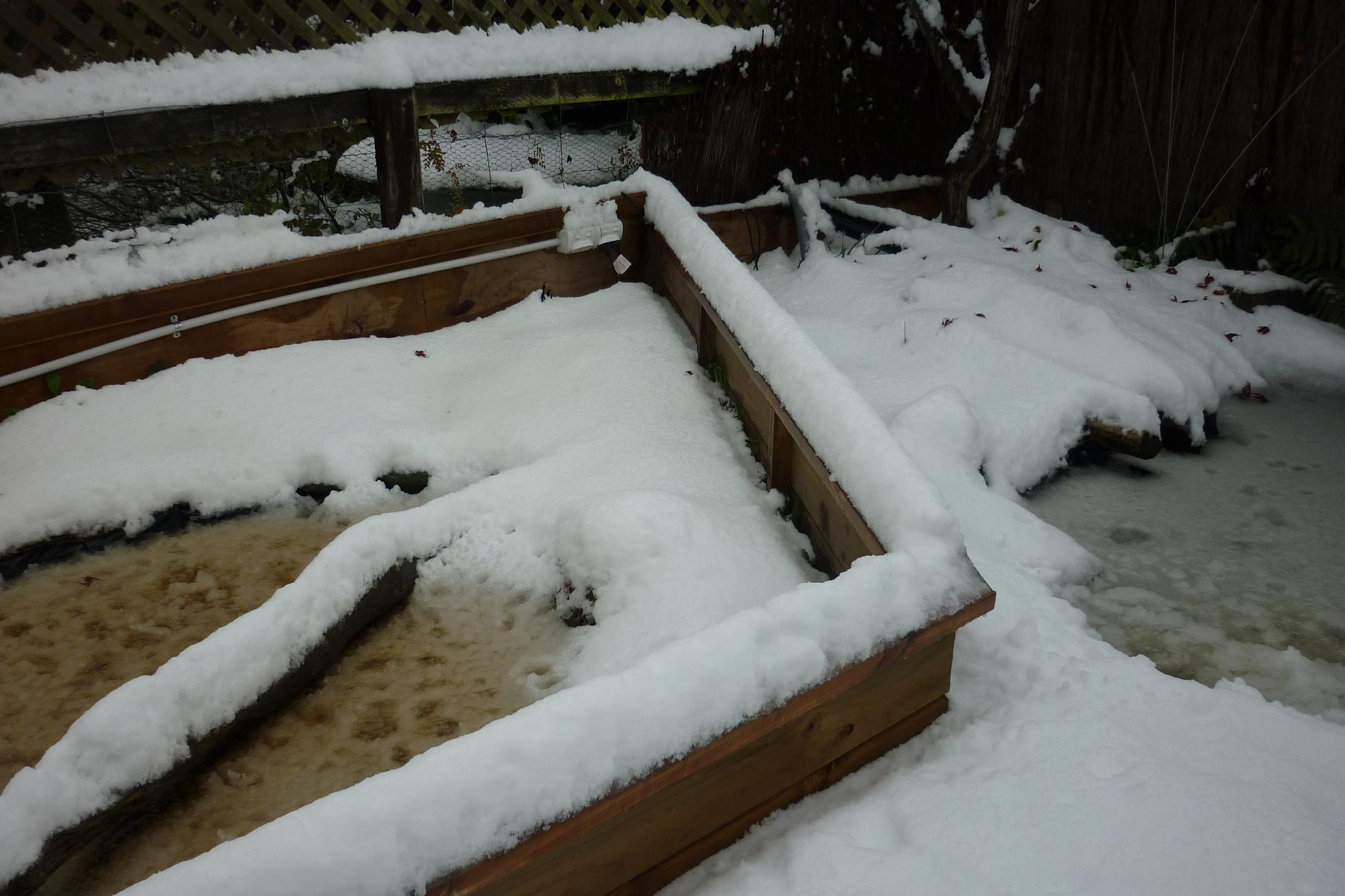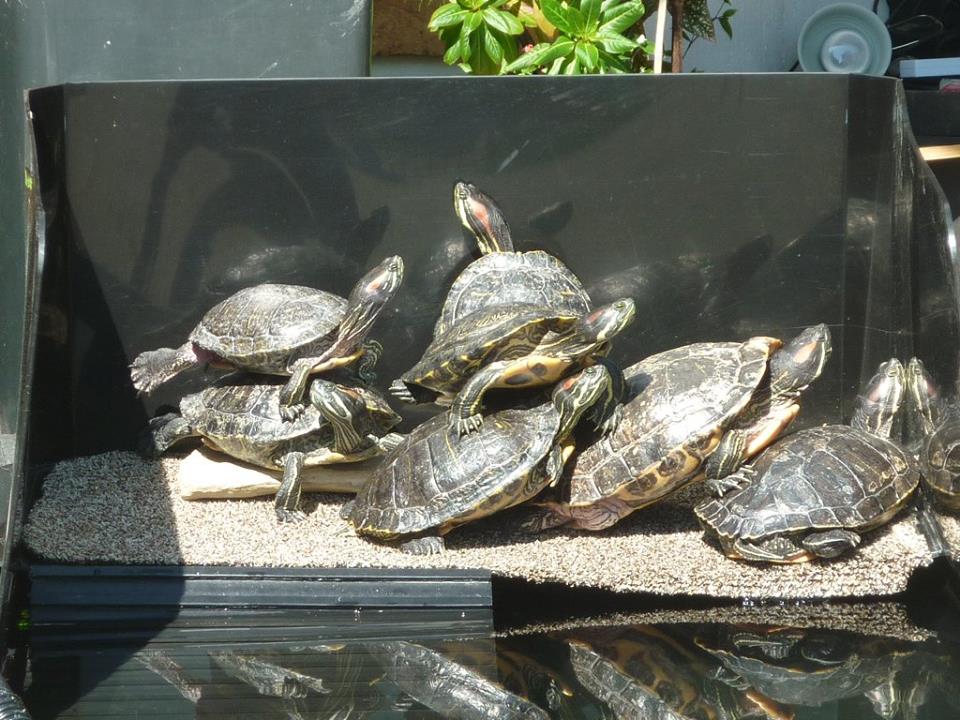DO NOT attempt hibernation without finding out some information about how to go about it successfully first
A turtle over 15cm in shell length and only if set up properly, can live outside in a soft environment. That means either
a natural clay bottomed pond, or pond-liner over sand or carpet.
DO NOT use concrete and avoid any rough rocks.
Have water two feet deep for adult females and ensure theres nothing the turtle can bang into when it slides into the water.
Position your pond for maximum sunlight, as turtles need a sunny basking area with access to shade. Artificial grass, logs, garden or lawn make a suitable basking area.
Use vermiculite or a mix of clay and loam or fine soil to provide a suitable egg laying place for your female. For hibernation an ideal is to have mud in the bottom of your pond, 46 cm below the frostline,for them to burrow into.

Fencing an Outdoor Pond
I've had turtles scale a 1 metre fence!
Secure fencing is critical to prevent escapes from an outdoor pond. Turtles can squeeze through Small gaps, climb up netting and shrubbery, or dig their way out; particularly a female wanting to lay eggs.
Use smooth wood or large, natural boulders or plastic netting with an overhang at the top. Whatever you choose, remember other animals, children and burglars can also be an issue for your turtles outside so think carefully about where you want to position your pond.
Fencing has an overlap at the top to prevent turtles climbing up and over the netting fences.The wooden retaining wall is very good to stop them escaping as well.
Personally I would not risk hibernating Eastern Long Neck Turtles (Snakenecks/ ELNS) in our South Island temperatures. However North Island ponds have more success if the turtle has plenty of mud or other media to burrow into, water is relatively deep and there is some shelter around or over the pond. Check out the Australian Freshwater Turtles Forum for excellent advice on caring for your ELN species of turtle. ELNs are far more suseptible to the cold then the Red Eared Slider turtles.
Red Eared Sliders can be hibernated outside in most parts of New Zealand, but it is still a risk in the the colder areas.
Even with doing everything right, you can still have fatalities during hibernation or turtles that are too sick when they come out of hibernation to survive.
Recently I knew of 9 RES deaths in the Sth Island during winter...and those were only the ones I had contact with
Your turtle must be well aclimatised to pond life for many months BEFORE attempting to hibernate it.

Turtle needs to be minimum of 15cm in shell length and healthy. Stop feeding your turtle by the end of April. Don't be tempted to keep feeding it. Turtle needs to be completely empty of food before hibernating or the food will rot inside and kill it. Pond should be below the frostline. It's suggested water should be a minimum of 40cm deep. Turtle MUST have something in the water to burrow into to keep warm. eg/ a mud lined pond, plants or even add an amount of barley straw to soften so the turtles can burrow into it. (Barley straw only, not other types). DO NOT OVER-DO THE BARLEY STRAW as your pond will start to smell and ferment! A few handfulls of straw may be all you need in a small pond. If your pond doesn't have much for the turtle to burrow in, try placing a couple of large pot-plant pots full of mud into your pond so they sit well below the surface of the water. This will give your turtle something to burrow in to and help him to remain warm during the winter months.
One picture shows the temporary decking with Barley straw under it for turtles to climb into for winter to hibernate.
The Windmill was added for filtration and the Pond is made with dam liner.The liner is then placed over island and a hole is cut in liner so island can be used for egg laying and plants.
NOTE: Turtle eggs don't hatch...they turn into compost! :)
Some turtles will hibernate out of the water buried deeply in the garden or under plants or a compost pile, but this is rare for aquatic turtles. Most will remain in the water. Ensure your pond is very sheltered and receives plenty of sun when it is available during winter. You may want to add a temporary 'tunnel house' type roof, or cover some of the pond with wood to increase the sheltered areas for the turtle. Keep your filtration going and do a water change on a warm day about the time you stop feeding them. NB/ don't add lots of cold water to your pond as you may cause cold-shock and death. Try and keep the temperature the same as before you started the water change. If you have to do a water change during winter, keep it small! A few buckets carefully removed and replaced with luke warm water is best. You do not want to disturb your turtle at all.
During hibernation turtles may still exit the pond to bask on a warm day. DON'T feed them or disturb them in any way. Just let them be. Feeding can begin again once the weather starts to warm up about October. When your turtles are active and appear hungry (not just habitually greedy...) start to feed a little. Don't over feed. If your turtles are basking and not rushing at you for food, they are probably still not needing any. Having aquarium plants, watercress, O2 weed etc in the pond will allow the turtles to start nibbling when they feel like it.
DO NOT pick up the turtle and lift it out of the water during hibernation as this can kill them. You may see the turtle moving slowly around the bottom of the pond or resting. The turtles entire body has slowed down dramatically and interferring can lead to problems. HOWEVER, if your turtle appears flat, head and limbs extended and floppy and is unresponsive if gently touched/pushed with a net, then it is in trouble. Turtle must be immediately removed from the water and may require Turtle CPR to revive it. If this is the case, the turtle will not be able to return to hibernation when it has recovered and should be kept in an aquarium inside. Some turtles will not hibernate. They are basking alot, restless, swimming about....these turtles need to be brought inside to an aquarium or they are unlikely to survive winter.
For hibernation an ideal is to have mud in the bottom of your pond, 46 cm below the frostline,for them to burrow into. Dont attempt hibernation without finding out some information about how to go about it successfully first.
Turtles have cold- blooded metabolic systems that require outside heat to provide the energy for movement and to sustain life. Aquatic turtles (living in ponds) cannot survive winter and must go into hibernation. (Turtles in tanks should not hibernate!) Turtles possess a normal warm-climate metabolism that functions roughly 10x slower then warm blooded mammals of the same size.
During winter, turtles metabolism will drop a further 10-20 percent. A turtles' summer heart rate is 40 beats per minute. Winter heart rate will drop to one beat every 10 minutes during winter hibernation.Turtles have lungs but are unable to use them underwater. They have no gills to trap oxygen. Turtles have specially designed throats and mouths which have special linings that trap minute oxygen air molecules and absorb them into very small capillaries.
But this does not fully oxygenate the turtles' system. An additional pair of thin-walled sacs near the anus traps and dissolves minute amounts of oxygen. The throat and mouth, in conjunction with the anal sacs, creates a barely detectable pumping action which intakes oxygen from both sides of the body and distributes it. (Amazing stuff!)
Toxic disposal.... When the turtle absorbs oxygen through the throat and anal sacs, large stores of carbon dioxide and lactic acid build up in its body. They cannot breathe to expel it. Instead their shells emit calcium salts, which enter the bloodstream and neutralize the toxic gases and chemicals.The process is similar to the way calcium carbonate dilutes and neutralises stomach acid in a human. (Clever turtles!)
